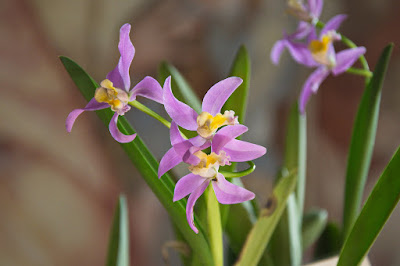Laelia longipes is endemic to southeastern Brazil (Serra do Cipó). It is found in mountains east of Belo Horizonte in the state of Minas Gerais at elevations around 1300 to 2000 meters above sea level.
Laelia longipes also called as The Long-Peduncled Laelia, Long-column Sophronitis, Laelia lucasiana, Bletia longipes, Bletia lucasiana, Cattleya longipe, Hoffmannseggella longipes, Laelia longipes var. lucasiana, Laelia ostermeyeri, Sophronitis longipes, is a species of the genus Laelia. This species was described by Heinrich Gustav Reichenbach in 1863.
IDENTIFY LAELIA LONGIPES ORCHID PLANT
Laelia longipes is endemic to southeastern Brazil (Serra do Cipó). It is found in mountains east of Belo Horizonte in the state of Minas Gerais at elevations around 1300 to 2000 meters above sea level.
The Long-Peduncled Laelia is a miniature sized, cool to cold growing, rupicolous, lithophytic species with narrowly oblong or conical, 2-4 cm long pseudobulbs carrying a single, apical, erect, fleshy, rigid, elliptic-oblong, subacute, dark green, 3-5 cm long leaf. New growths are produced close to the last growth making the plant compact.
Long-column Sophronitis blooms in the summer and fall in Brazil on a raceme that is much longer than the leaves and has from 2 to 4 flowers and sometimes more. The flowers are 5 cm in diameter, small, brightly colored range from pink to rose-lavender. The lip is darker than the petals and has a yellow or golden yellow throat.
LAELIA LONGIPES ORCHID PLANT CARE AND CULTURE
Cultural information should only be used as a guide, and should be to be adapted to suit you. Your physical location; where you grow your plants, how much time you have to devote to their care, and many other factors, will need to be taken into account. Only then can you decide on the cultural methods that best suit you and your plants.
Light:
Laelia cinnabarina like good light (30000-40000 lux) with about 30-50% shade in summer but no direct sun. They require high light intensity during their dormant period in winter. They like direct morning sun but avoid afternoon light and deep shade.
Temperature:
The Long-Peduncled Laelia come from environments that have a normal temperature range of 16°C to 24°C with winter temperatures of about 12°C and rarely experience temperatures below 8°C.
Humidity:
Long-column Sophronitis need good air movement year round. They require moderate to high humidity (50-70%) in summer but low humidity in winter.
Substrate, growing media and repotting:
Laelia longipes are usually grown in pots. Some growers recommend placing pieces of sandstone in the potting mix if root growth is a problem. Always use the smallest pot possible as they dry faster and large pots increase the risk of root rot.
This species don’t like being disturbed, when they outgrow the pot some growers simply place the plant and its pot into a slightly larger pot (over pot) allowing the roots to fill the space between the two pots. Repotting may be necessary however when the bark becomes decomposed.
Watering:
In their native environment this orchid receive daily rain in summer and so should receive regular watering during the warmer summer and autumn months, preferably daily in hot weather. Plants on slabs should be watered daily in warm weather. This species experience a 2-3 months dry season.
Fertilizer:
Liquid fertilizers should be applied regularly during the growing season but not in winter. Some growers recommend a low nitrogen but high phosphorus fertilizer in late summer and autumn. Liquid seaweed fertilizer can also be applied.
Rest period:
Laelia longipes have a short 2-3 months dry period. Fertilization should be limited or should be completely abandoned until spring, when stronger watering resumes. In the natural habitat, the light is strongest in the dry winter period, so the plants grown need as much winter light as possible.















COMMENTS